
Consulting Entomologist

Tel/Fax: 01275 854224
E-Mail: [email protected]
Site Guide
Site Search
Home Page
Career Page
Insect Files
- Contents
- Bug Index
- The World of Bugs
- Classification of Bugs
- Insect Identification
- Insect Fossils
- Insect Body-parts
- Micro View of Bugs
- Insect Life Cycles
- Insect Defences
- Insects of Nailsea
- Pesticide Safety
- Bibliography
Shortcut to the main groups of insects and other arthropods...
Bug Rhymes & Poems
Links
Shop
Payments (credit/debit card)
Insect FossilsInsect fossils preserved in rock and amber provide evidence and clues of how and when different insects evolved since their first appearance on Earth around 450 million years ago. |
 |
OVER THE MAIN GEOLOGICAL PERIODS OF EARTH HISTORY
| ERA | PERIOD |
MAX. AGE 1 (millions of years) |
INSECT FOSSILS (earliest found) |
OTHER FOSSILS (earliest found) |
|---|---|---|---|---|
| CAENOZOIC (Quaternary) | Halocene | (present) 0.01 |
||
| Pleistocene | 2 | modern man (last man-apes) | ||
| CAENOZOIC (Tertiary) | Pliocene | 5 | man-apes | |
| Miocene | 25 | butterflies, ants | ||
| Oligocene | 40 | many insects similar or identical to our present fauna trapped in baltic amber | ||
| Eocene | 60 | |||
| Palaeocene | 65 | |||
| MESOZOIC (Secondary) | Cretaceous | 145 | birds, flowering plants (last dinosaurs & ammonites) | |
| Jurassic | 210 | earwigs, sawflies | mammals | |
| Triassic | 245 | caddis flies, beetles, true flies | dinosaurs, coniferous plants | |
| PALEOZOIC (Primary) | Permian | 285 | dragonflies, mayflies, stoneflies, lacewings, crickets, true bugs | reptiles, ammonites (last trilobites) |
| Carboniferous | 360 | cockroaches, many archaic insects that all disappear in the late Permian leaving no modern descendants |
amphibians | |
| Devonian | 410 | springtails | spiders, ferns and other similar land plants | |
| Silurian | 440 | scorpions | ||
| Ordovician | 505 | fishes | ||
| Cambrian | 540 | trilobites, worms, molluscs, corals | ||
| PRE-CAMBRIAN | Proterozoic | 2500 | unicellular organisms (algae, fungi, bacteria) | |
| Azoic (Archaean) | 3900 | |||
| (PRE-GEOLOGIC) | (4600) | (formation of Earth) | ||
| 1 The figures cited are approximate and are subject to continual revision (1 million = 1,000,000) | ||||
| |
The oldest insect fossils so far discovered are tiny imprints of wingless insects found in sandstone rocks of the mid-Devonian period (c. 380 million years old). These earliest fossils closely resemble modern springtails (Collembola) and even by this time they show most of the specialised evolutionary features that characterise the present-day members of this insect order (e.g., the reflexed 'tail' used for jumping). This would suggest that the insect-stock from which they arose must have been already very old in Devonian times, and that the first primitive wingless insects probably appeared much earlier, at least in the Silurian, around 410-440 million years ago. The earliest fossils of winged insects come from the coal-measures of the mid-Carboniferous (c. 320 million years old). These include the remains of cockroaches (Dictyoptera), some of which are little different from present-day species. It would seem that this group have survived more or less unchanged perhaps from Devonian times (i.e., for about 360-400 million years). The same coal deposits also contain the fossils of diverse archaic insects belonging to ancient lines that, unlike the cockroaches, gradually disappeared before the end of the Paleozoic era, leaving no modern descendants. Many of these archaic forms are huge dragonfly-like insects, with a wing-span of 20 cm or more, like the Palaeodictyoptera and Protodonata illustrated below - true 'dinosaurs' of the insect world. |
| |
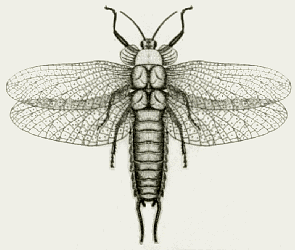 Homoioptera (wing-span 20 cm) A large archaic insect belonging to a group called Palaeodictyoptera |
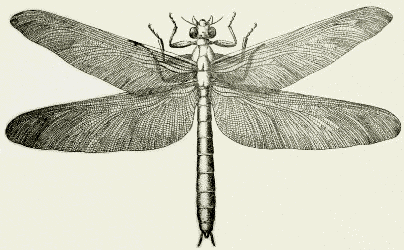 Meganeura (wing-span 70 cm) A huge archaic dragonfly-like insect belonging to a group called Protodonata |
| The drawings above are reconstructed from fossils found in rocks of the Carboniferous period, about 320 million years old (modified from: R. Jeannel. 1960. Introduction to Entomology. Hutchinson, London.) | |
| |
Apart from cockroaches with their early origins in the Carboniferous or even earlier, fossils of other winged insects that clearly belong to modern orders first appear in the rock deposits of the Permian (c. 250-280 million years old), and include a diverse assemblage of dragonflies (Odonata), mayflies (Ephemeroptera), stoneflies (Plecoptera), lacewings (Neuroptera), crickets (Orthoptera) and bugs (Hemiptera). These are followed by caddis flies (Trichoptera), beetles (Coleoptera), flies (Diptera), earwigs (Dermaptera) and sawflies (Hymenoptera) in Triassic and Jurassic deposits (c. 150-240 million years old). The fossil remains of a few groups appear much later. For example, there are no authenticated fossils of moths and butterflies (Lepidoptera) before the Eocene period and most of those found so far come from Oligocene and Miocene deposits (c. 25-40 million years old). The relatively recent arrival of this latter group onto the insect scene (with mouthparts specially adapted for sucking nectar from flowers) is almost certainly linked to the appearance and spread of flowing plants in the late Mesosoic and early Tertiary eras. The approximate first appearance of these various groups of insects as fossils in the geological record, and the appearance of other animals and plants, is summarised in the table at the top of this page. |
| |
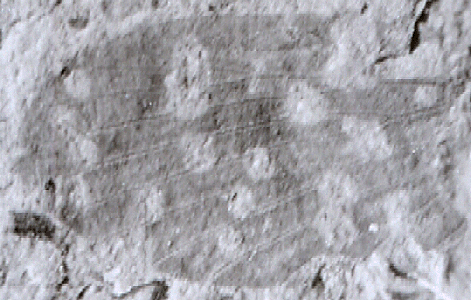 Fossil imprint of part of an unidentified insect wing (width top to bottom, about 5 mm) |
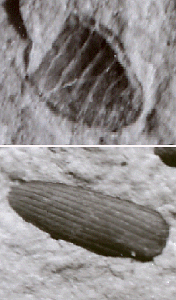 (Top) Fossil imprint of a beetle abdomen (length 2-3 mm) (Bottom) Fossilized wing-case of a beetle (length about 4 mm) |
| Fossil imprints and fragments of insects found in Triassic sedimentary rocks, about 220-240 million years old, from the Severn Estuary in Southwest England, UK | |
| |
The fossils of insects found in rock deposits are often only fragments of body parts, like those illustrated above. Although such fragments might be easily identified as belonging to a general group or particular insect order, those that an expert could recognise again with confidence as being the same as a fossil species already described, or perhaps identical or similar to a species that still exists today, are very few. This is not the case for most insects trapped and 'fossilized' in amber (the solidified resin of pine trees), where specimens are often beautifully preserved in their entirety, so allowing accurate identification of species. |
| |
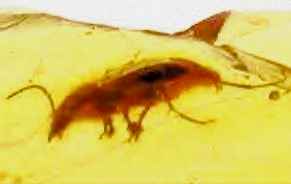 Ground Beetle Coleoptera: family Carabidae (length about 5 mm) |
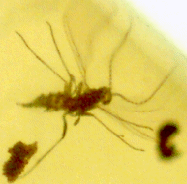 Gall Midge Diptera: family Cecidomyiidae (length 1-2 mm) |
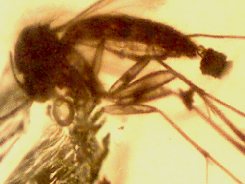 Fungus Gnat or Sciarid Fly Diptera: family Mycetophilidae (length about 3 mm) |
| Insects preserved in Baltic amber 2 from the lower Oligocene period, about 35-40 million years old (the same or similar species still exist today) | ||
| |
Baltic amber 2 from the lower Oligocene (c. 35-40 million years old) is perhaps the richest source of amber-preserved insects. All the insects so far discovered in amber deposits are familiar types that clearly belong to modern orders and families, and in many cases they belong to species that still exist today. These include, among the wingless insects (Apterygota), a great variety of springtails (Collembola) and bristletails (Thysanura); among the winged insects (Pterygota), many cockroaches and mantids (Dictyoptera), stoneflies (Plecoptera), stick-insects (Phasmida), earwigs (Dermaptera), termites (Isoptera), bugs (Hemiptera), thrips (Thysanoptera), beetles (Coleoptera), flies (Diptera) and so on - in fact, representatives of most of the insect groups recognised in our present-day classification. Three examples are illustrated above. Thus, as in nearly all groups of animals and plants, the process of evolution over the ages has resulted in many diverse insect faunas, each comprised of different insect groups and species. The fossil record shows that many ancient forms flourished for a time and then became extinct, to be replaced by more successful types better suited to the ever changing climatic and other environmental conditions of the Earth's land masses. In a general view, however, the insects as a whole must be looked on as very ancient inhabitants of the Earth, probably at least twice as old as the reptiles and three times as old as the mammals - perhaps nearly a thousand times as old as our own mammalian group, the hominids. In many cases, even the common and familiar insect species that we encounter nearly everyday in our homes and gardens have existed in their present form for at least 35-40 million years before mankind first appeared on Earth - something to ponder the next time you swat a fly! |
2 Baltic amber, as its name suggests, comes from the general region of the Baltic Sea (and also the North Sea), with deposits found in nearly all the bordering countries of the Scandanavian Penninsula, Northern Europe and Russia. This huge area was covered by pine forest in the Eocene and Oligocene periods. |
|
Click here for all the modern Insect Orders (classification of insects) |
| <<< TOP | (use the back button on your web browser to return to the previous page) | TOP >>> |